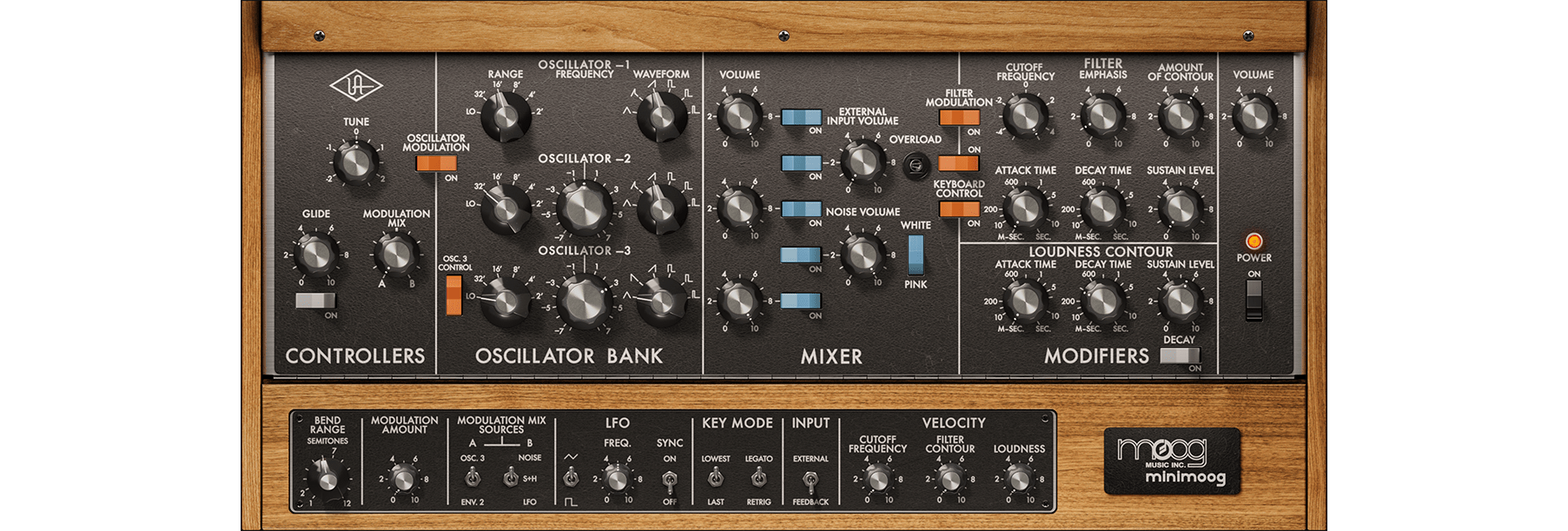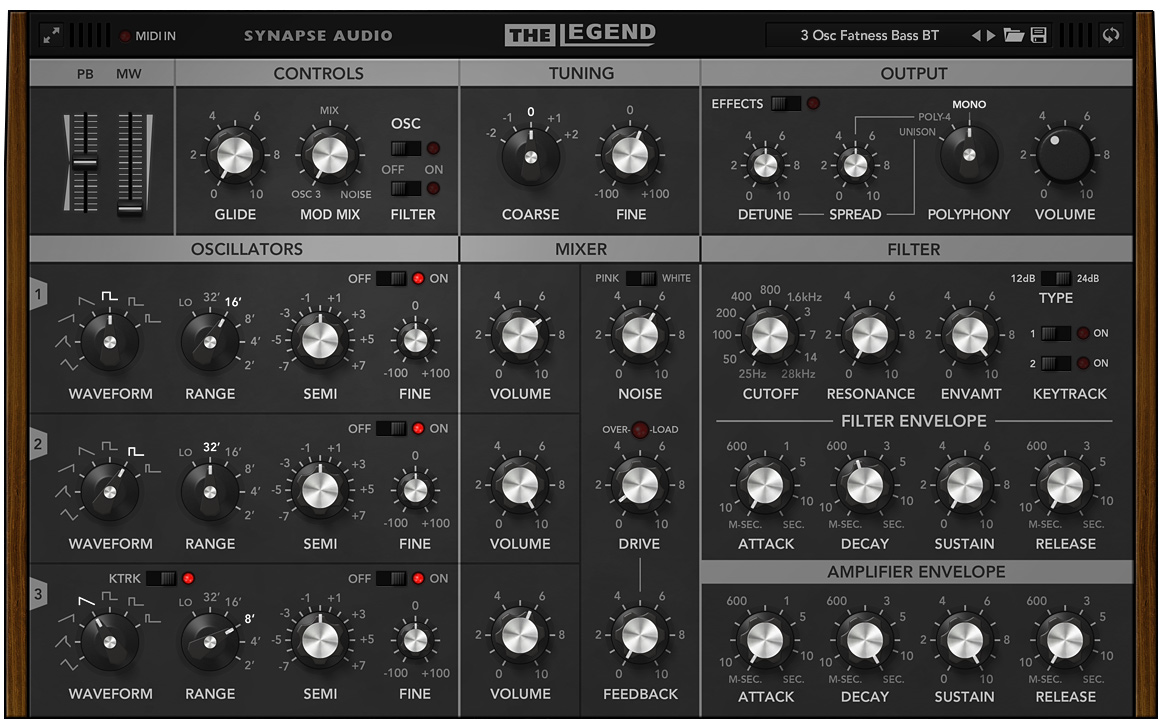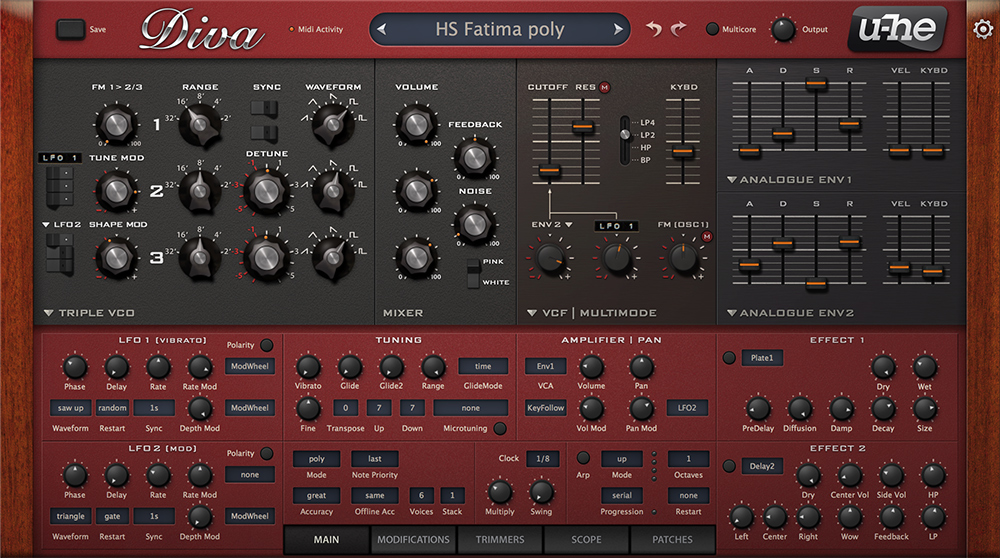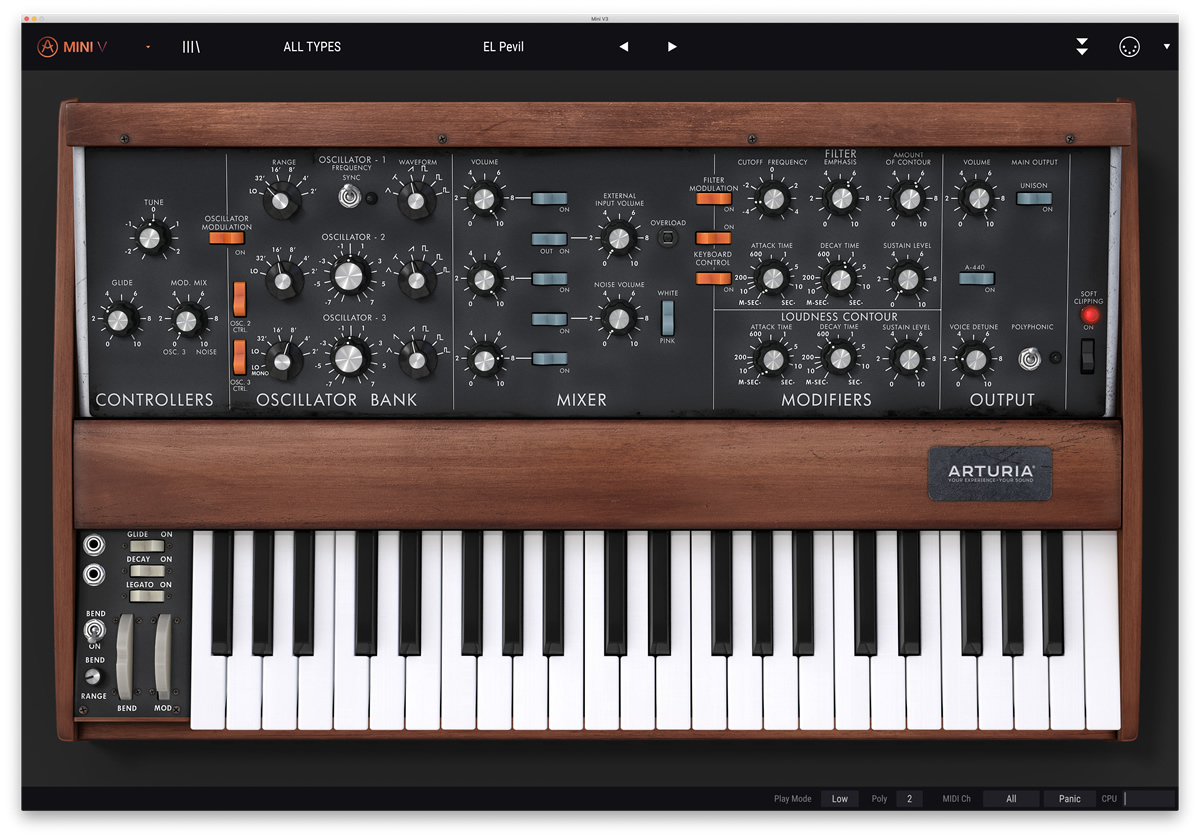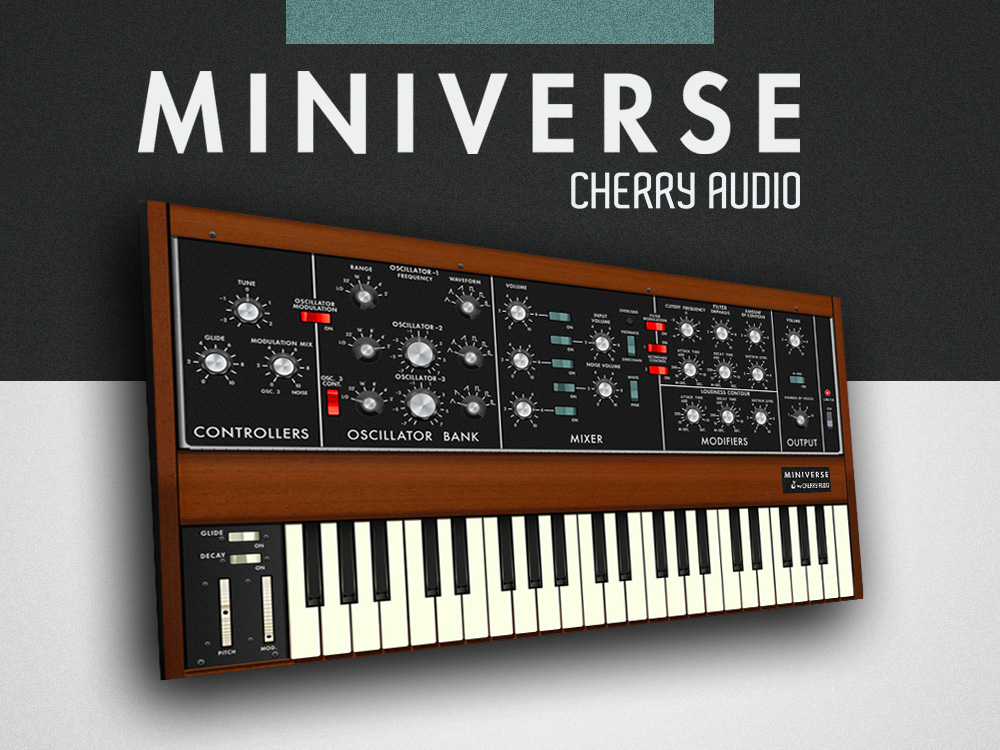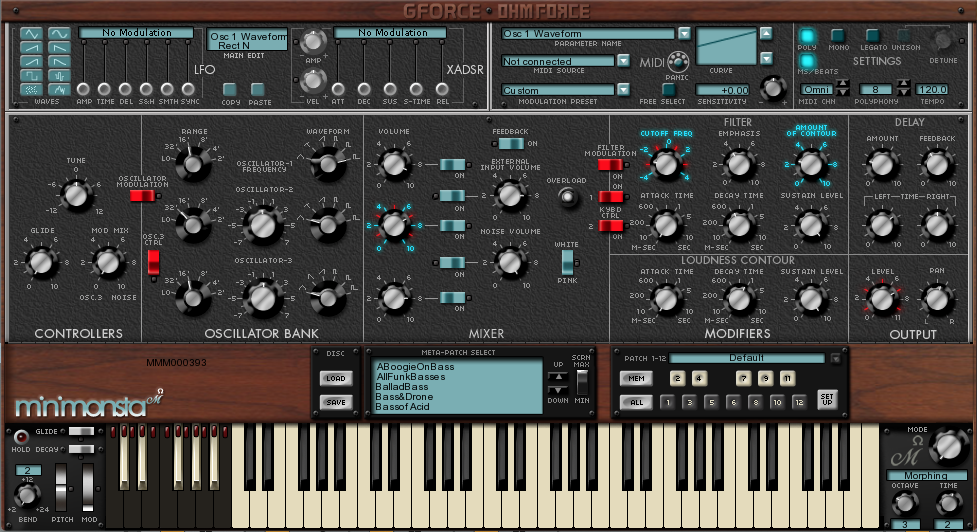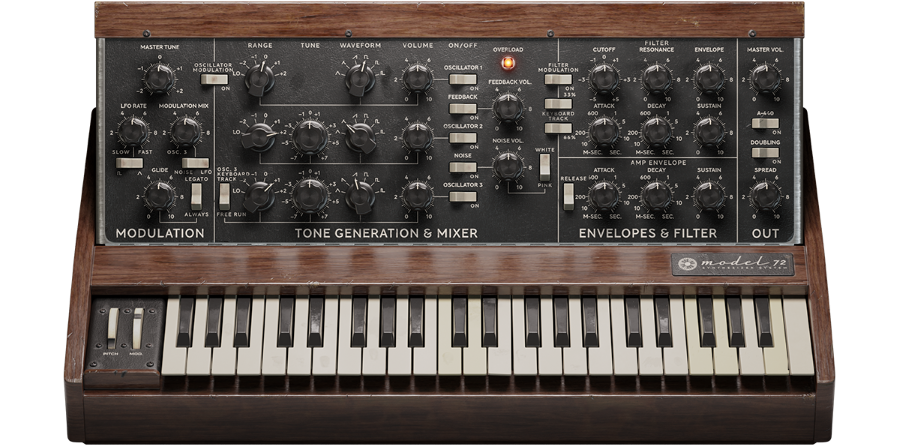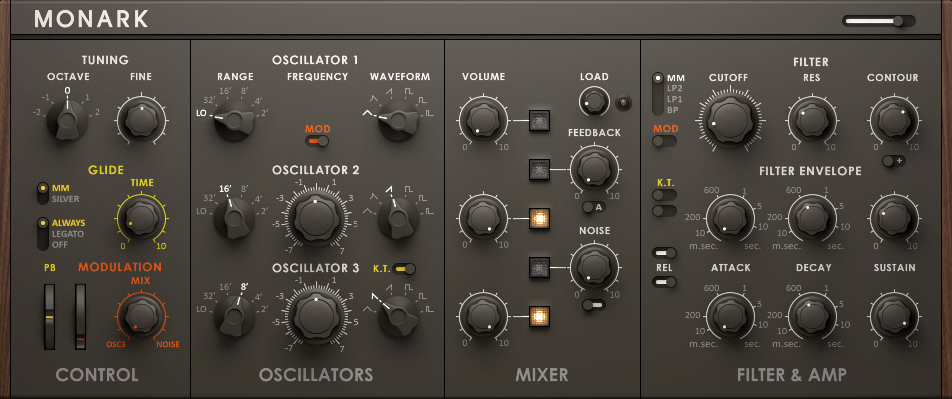8 of the best Minimoog VST emulations
By The Article Master on
The Moog Minimoog is undoubtably the most celebrated and well known synthesizer of all time and as such has inspired numerous VST emulations over the past years.
First manufactured by Moog Music in 1970, it was designed as a more affordable, user friendly, portable variant of the Moog modular and was the first synthesizer to retail in stores.
Features of the original Minimoog:
- 3 voltage controlled oscillators offering several waveforms (Triangle, Saw triangle, Saw, Square, wide rectangular and narrow rectangular). The third oscillator can modulate either the first two oscillators or the filter.
- 1 mixer built with an overload circuit.
- 1 legendary 24db/oct resonant filter.
- 2 ADSR envelope generators.
- 1 external audio input.
- 1 external oscillator and filter modulation input.
Developed in partnership with Moog Music, exclusively for Universal Audio, the Moog Minimoog thoroughly captures every nuance, anomaly, and quirk of the original hardware using Universal Audio's industry‑leading expertise in circuit modeling, synthesis, and signal processing.
Key Features:
- Painstaking circuit emulation of Moog's most famous analog synthesizer used by Kraftwerk, Stevie Wonder, Yes, Dr. Dre, and hundreds more.
- Fully endorsed by Moog Music.
- Faithfully captures all module-to-module coupling, impedance matching, and nonlinearities of the original Minimoog Model D.
- Exacting capture of iconic Moog oscillators, ladder filters, pitch tracking/stability anomalies, and more.
- Discrete transistor VCA modeling.
- Custom Moog mods, including switchable note priority, legato, sample and hold, extra LFO, and more.
The Legend HZ
Developed in cooperation with vintage synth specialist Bigtone Studios, The Legend marks new territory in analog modeling technology. Every component, ranging from the voltage-controlled oscillators (VCOs), voltage-controlled filter (VCF) and voltage-controlled amplifier (VCA), have been modeled to an accuracy never seen before in software. The snappy filter and amplifier envelopes have been meticulously modeled, as well as the massive bottom end - even the most marginal effects like temperature drift or effects originating from the power supply have been taken into account.
Furthermore, The Legend offers additional controls not found on the original hardware, greatly enhancing its versatility. The most significant additions are the Unison and Polyphonic modes, allowing for thick stereo sounds, as well as enabling polyphonic play. Built around a vectorized core, The Legend is capable of synthesizing four voices for the cost of little more than a single voice, making it a highly efficient analog-modeling synthesizer plug-in.
Another bonus feature of The Legend is its on-board effects, comprising a high-quality delay and reverb unit. Both effects are tailored to the synthesizer, and offer just the right sound with only a few parameters each.
The Legend comes with more than 400 patches crafted by leading sound designers and sorted into common categories like Bass, Lead, SFX, etc. The patches comprise both new sounds as well as a large collection of vintage sounds.
Diva's oscillators, filters and envelopes (which can be mixed and matched) closely model components also found in some of the great monophonic and polyphonic synthesizers of yesteryear. "But, " says Urs, "what truly sets DIVA apart is the sheer authenticity of the circuit emulations – at the cost of a relatively high CPU-hit, DIVA is the first native software synth that applies methods from industrial circuit emulators (search for "PSpice") in realtime. Especially the authentic behaviour of DIVA's zero-delay-feedback filters, when pushed to the limits, demonstrates the advantages of this groundbreaking approach."
u-he describes the available filters as "famous transistor ladder", "screaming Sallen-Key", "classic OTA ladder" and "OTA state-variable" (and similar for the oscillators), and owners of classic analogue synths will already know how best to apply these models – they are easily differentiated in the gorgeous user interface.
Since Version 1.3 Diva also features a Digital Oscillator, an "Uhbie" filter and a vintage-style Arpeggiator.
Was $199.00; Save $100.00 until 19 Aug 2024!The original minimoog has particular characteristics for which it was both loved by many musicians to this day. Arturia Mini V (formerly know as minimoog V) brings back the sound and special characteristics in a virtual instrument.
Additional features of the software version include a modulation matrix offering up to 6 different connections, 12 sources and 27 destinations, an LFO with sync to host, an arpeggiator, a three-mode chorus, stereo delay and the possibility to synchronize Osc2 to Osc1.
The latest version, Mini V4, is an entire rewrite of the plugin, with substantial improvements being made. This is particularly evident the filter section, which has more growl and character now than ever.
Features of the original Minimoog:
- 3 voltage controlled oscillators offering several waveforms (Triangle, Saw triangle, Saw, Square, wide rectangular and narrow rectangular). The third oscillator can modulate either the first two oscillators or the filter.
- 1 mixer built with an overload circuit.
- 1 legendary 24db/oct resonant filter.
- 2 ADSR envelope generators.
- 1 external audio input.
- 1 external oscillator and filter modulation input.
Additional features of the software version:
- 1 modulation matrix offering up to 6 different connections. 12 sources and 27 destinations.
- 1 LFO with sync to host.
- 1 arpeggiator with sync to host.
- 1 three-mode chorus.
- 1 stereo delay to be synchronized via MIDI.
- Possibility to synchronize Osc2 to Osc1.
Miniverse is a painstaking virtual emulation of the granddaddy of all portable synthesizers, the legendary Minimoog Model D. Introduced in 1971, no other instrument is more associated with the word "synthesizer" than the iconic Minimoog - it's perhaps the best-known and loved analog synthesizer ever made. Though its innards weren't identical to Moog's massive modular synths, it shared the thick, juicy, "fat" analog sound that remains unchallenged 50 years later. It set the standard for future synthesizers, inspired whole new genres of music, and defined the sound of artists as diverse as Kraftwerk, Herbie Hancock, Rick Wakeman, Pink Floyd, Parliament, Gary Numan, and countless others.
Miniverse was conceived as the ultimate tribute to the original instrument. Cherry Audio focused on a single principle: absolute authenticity. In association with DSP master and frequent collaborator Mark Barton (MRB), they studied and measured every nuance, every curve, and every response of the audio. Even the Miniverse interface is a meticulous recreation of the Minimoog, from the maple cabinet and textured surface to the unmistakable "Cosmo" knobs and switches. They've avoided the temptation to add extra features, such as additional LFOs or effects, which might distract from the spirit and vibe of the classic Model D. Instead, Miniverse portrays the pure, raw, powerful sound and feel of the classic original.
Whether you're seeking monstrous leads, funky basslines, or warm atmospheric pads, Miniverse has you covered.
Minimonsta2
Minimonsta is an award winning, highly detailed and accurate emulation of the original instrument with heaps of attitude. We think of it as a mini emulation on steroids because, until the Minimonsta, numerous clones simply attempted to copy the original instrument and then add one or two features such as polyphony and another LFO, the Minimonsta takes a radically different look at this vintage masterpiece and operates on two levels.
It comes with over 6000 factory patches (including many from Rick Wakeman). All original features including 3 oscillators and the famous 4-pole, 24dB/octave filter. Additional LFO & ADSR for modulation of almost every parameter making it the most programmable one.
The original minimoog was manufactured between 1971 and 1982 and was an instant classic thanks to its musician friendly logical layout, tactile front panel, warm oscillators and powerful 24db lowpass filter. in its time 13,000 were sold but if you want one now be prepared to pay handsomely.
In short, think of the Minimonsta as a modular Mini but without all the clutter of patch cords. Instead of being shackled to a single LFO as per the original instrument, it's possible to assign an LFO to almost any original Mini parameter including filter cutoff, resonance, individual oscillator volumes, even each envelope parameter. What's more, each LFO has several waveforms, sync, and delay options from which to choose. Additionally, for every parameter to which you can apply an LFO, it's also possible to apply an extra ADSR. Finally, there's also the ability to assign MIDI modulation to any original Mini parameter and create effects such as dynamic glide times or velocity response to filter (both positive and negative). Put simply, the scope for sound design and sonic creativity is limitless.
Model 72 is based on a fully modeled vintage monophonic synthesizer that has been a true legend in music instrument history since its introduction in 1970. Affordable, easy to use, and small enough to carry around to studios and gigs, it was the first synthesizer designed for and accessible to musicians and became the archetype for all synthesizers that followed. The sounds it produces can be warm, lush, and luxurious or fat, distorted, and gnarly but not at all ear-piercing.
The software components of Model 72 were measured and matched down to the smallest details from the original hardware, keeping all of its quirks and non-linearities intact. For example, one trick that's commonly used on the hardware version is connecting a cable from the high-gain output to the external input of the unit to create a roaring, raw, and exciting feedback tone heard on countless records. Obviously, we had to add this feature to the Model 72 Instrument plug-in.
The synth is updated with some new features, too. An expansion panel lets you tweak some of the finer details of the oscillator behavior as well as some performance aspects of the synth. The doubling feature adds the effect of having the notes that are played doubled by another Model 72, and the spread feature sets how much this doubling will spread out in the stereo field. These improvements allow you to do even more than you could with the original hardware.
Monark captures the pure organic sound of the king of monophonic analog synthesizers. Years of meticulous research capture every nuance of the synth at the center of four decades of popular music.
Monark runs in Reaktor Player or the full Reaktor 5 version, and is also optimized for easy browsing from the Maschine hardware.
Read More Best of

Discussion
seriously the Arturia one is the worst i ever heard. You should also consider the UAD-x Minimoog ... to my ears one of the very best ones i ever heard.
Would be nice if Minimonsta was updated to play in latest Mac OS...although, I guess it is a bit long in the tooth for GForce to be committing resources towards.
What about the Moog au3 ? It is Moog after all :-).
Please log in to join the discussion

